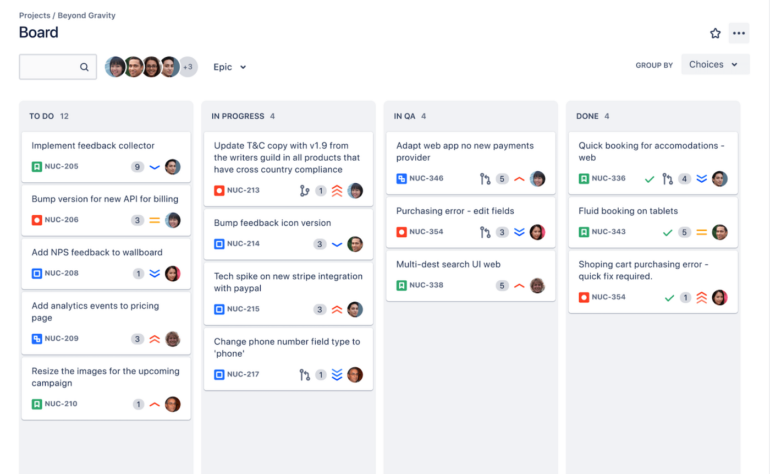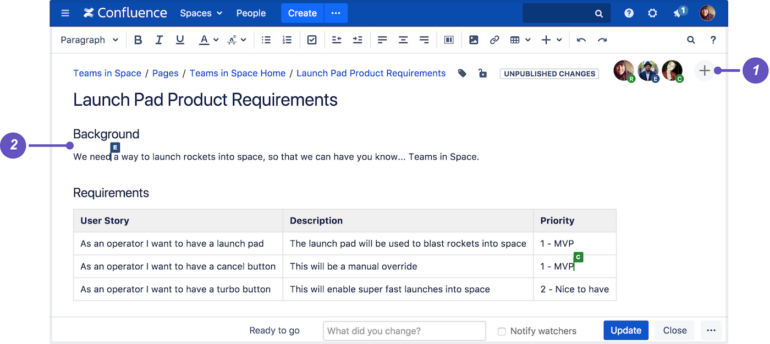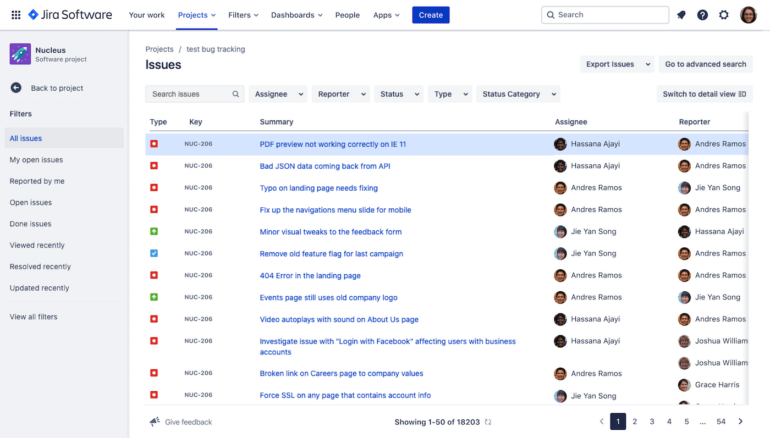Jira and Confluence are two popular project management software. While they are both designed to help businesses and individuals plan and track projects, they are very different tools. In this article, we share the pros and cons of each software. We also highlight how they compare in terms of core and advanced features and pricing and share some tips on which software to choose for your organization.
Jump to:
- What is Jira?
- What is Confluence?
- Jira vs. Confluence: Comparison table
- Jira and Confluence pricing
- Feature comparison: Jira vs. Confluence
- Jira pros and cons
- Confluence pros and cons
- Methodology
- Should your organization use Jira or Confluence?
What is Jira?

Jira, a product by Atlassian, is popular with software development teams as it offers outstanding bug-tracking and issue-tracking capabilities. However, it is also commonly used for other project management applications. Jira is an excellent choice for users who need kanban or scrum support, perform sprint planning or need to have the agility to scale the software according to changing business needs.
For more information, read our full Jira review.
What is Confluence?

Confluence is also developed by Atlassian. It is geared toward team collaboration and task management. While it may not offer the functionality of other advanced project management tools, Confluence is simple to use. The user-friendly interface and high level of customization make Confluence an ideal choice for project management software for small businesses, startups, freelancers and solopreneurs.
Learn more about the benefits of using Confluence.
Jira vs. Confluence: Comparison
| Jira | Confluence | |
|---|---|---|
| Kanban boards | Yes | No |
| Agile reporting | Yes | No |
| Team collaboration | Limited | Yes |
| Issue tracking | Yes | No |
| Native time tracking | Yes | No |
| Mobile app | iOS and Android | iOS and Android |
| Third-party integrations | Yes | Yes |
| Free trial | 14 days | 14 days |
| Starting price | $7.75 per user per month | $5.75 per user per month |
Jira and Confluence pricing
Jira pricing
Jira offers a free plan for up to 10 users for a single site. The plan offers customizable workflows, kanban boards, agile reporting, road mapping tools and file storage of up to 2 GB.
The Standard plan starts at $7.75 per user per month, with up to 35,000 users for a single site. Along with the features offered in the Free plan, you unlock administrative controls, including audit logs and data compliance features.
The Premium plan is priced at $15.25 and features advanced automation and road mapping tools. You also unlock tools for sandboxing, dependency management, premium support, IP-allow listing and a 99.9% SLA uptime agreement.
Enterprise accounts in Jira are customized plans tailored to the specific needs of organizations. This plan includes enterprise-level tools such as global scaling and advanced data security. For enterprise pricing, you will need to contact Atlassian directly.
Confluence pricing
Confluence offers a free plan for up to 10 users and with a maximum of 2 GB of file storage. Users get unlimited pages and spaces in the Free plan.
Starting at $5.75 per user per month, the Standard plan offers 50,000 users and 250 GB of file storage. Advanced features such as user permission and local business hours support are also available in this plan.
The Premium plans start at $11 per user per month. Several advanced tools are unlocked in this plan, including team calendars, analytics, unlimited storage, IP allow listing and a 99.9% SLA uptime guarantee.
The Enterprise plan is only available for organizations that need over 800 users. With this plan, you get 24/7 enterprise support, unlimited sites and other advanced tools tailored to your organization’s specific needs.
Feature comparison: Jira vs. Confluence
Kanban boards
Jira offers a kanban board view (Figure C) to help facilitate continuous delivery of work and easy visualization of project progress. This feature in Jira is customizable so that you can configure it according to your needs. The kanban boards feature is missing in Confluence; however, it is available through third-party integration. Users of Confluence can view project progress through tables and other project views.
Figure A

Team collaboration
Confluence excels in team collaboration by offering various tools, including real-time editing (Figure D) and shared spaces. Jira offers basic collaboration tools, such as notifying team members or assigning tasks; however, its team collaboration features are limited. With Confluence, you get advanced team collaboration tools such as control access permissions, knowledge sharing and task commenting.
Figure D

Agile reporting
Agile reporting allows users to use selected metrics to analyze data and make informed decisions. Jira offers agile reporting tools such as control charts and process flow diagrams. These agile reports in Jira provide insights into team performance and resource distribution. The agile reporting feature is not available in Confluence; however, it is available through third-party integration.
Issue tracking
Issue tracking refers to managing cases and tracking their progress. While this feature is most useful for software development teams, it can also be used for different project management applications. Jira is known for its robust issue-tracking capabilities, while this feature is not available in Confluence. With Confluence, users can collaborate on issues, but they don’t get a dedicated issue-tracking feature.
Figure E

Native time tracking
Native time-tracking tools allow users to manage and track time spent on tasks. Jira offers native time tracking. There is a built-in timesheet view and time-tracking reports in Jira. On the other hand, Confluence is more of a collaboration tool and does not have this feature.
Jira pros and cons
Pros of Jira
- Highly scalable.
- Outstanding issue tracking tools.
- Robust agile reporting tools.
- Variety of add-ons are available.
Cons of Jira
- Steep learning curve.
- Limited project views.
- Limited collaboration and communication tools.
Confluence pros and cons
Pros of Confluence
- Excellent collaboration tools.
- Extensive range of templates.
- User-friendly interface.
- Excellent customization tools.
Cons of Confluence
- Limited scalability.
- Limited document management capabilities.
Methodology
To compare the two products by Atlassian, we did a hands-on review to analyze the usability and features of each software. We looked at the layout of the user interface, the list of core and advanced features and customization capabilities. We also analyzed customer reviews and ratings from reputed websites.
Should your organization use Jira or Confluence?
Jira offers more advanced project management tools, including support for agile methodology and issue tracking. It is best suited for projects that require process management and iterative development. However, Jira has a steep learning curve. On the other hand, Confluence may not offer advanced tools but is easier to use.
Both Jira and Confluence are available on Linux and offer flexibility in implementation as they are available over the cloud and as on-premise project management software. Confluence is ideally suited for team communication and sharing knowledge with the team. You also have the option of integrating Jira and Confluence to get the best of both worlds.








